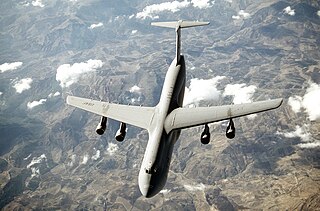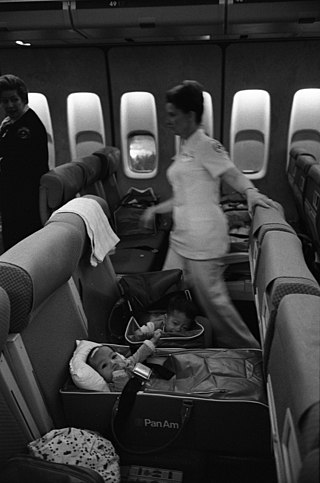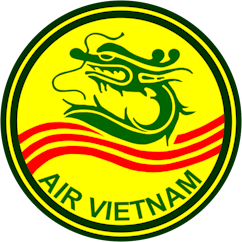
The Lockheed C-5 Galaxy is a large military transport aircraft designed and built by Lockheed, and now maintained and upgraded by its successor, Lockheed Martin. It provides the United States Air Force (USAF) with a heavy intercontinental-range strategic airlift capability, one that can carry outsized and oversized loads, including all air-certifiable cargo. The Galaxy has many similarities to the smaller Lockheed C-141 Starlifter and the later Boeing C-17 Globemaster III. The C-5 is among the largest military aircraft in the world.
This is a list of aviation-related events from 1975.

The fall of Saigon was the capture of Saigon, the capital of South Vietnam, by North Vietnam on 30 April 1975. The event marked the end of the Vietnam War and the collapse of the South Vietnamese state, leading to a transition period and the formal reunification of Vietnam into the Socialist Republic of Vietnam under communist rule on 2 July 1976.

Tân Sơn Nhất International Airport is an international airport serving Ho Chi Minh City, the largest city of Vietnam. It serves Tan Binh District, where the airport is located in the Ho Chi Minh City metropolitan area, as well as the rest of southeastern Vietnam. It is the busiest and largest airport in Vietnam, with 32.5 million passengers in 2016, 38.5 million passengers in 2018, and about 41 million passengers in 2023. As of December 2023, it is the 50th-busiest airport in the world, and the second-busiest in Southeast Asia. As of April 2024, it has a total capacity of only around 30 million passengers, which has caused constant and increasing traffic and congestion, hence it has sparked debates for expanding or building a new airport, of which the plan of the new airport as an alternative is under construction since 2021, and will be completed by 2025.

Operation Frequent Wind was the final phase in the evacuation of American civilians and "at-risk" Vietnamese from Saigon, South Vietnam, before the takeover of the city by the North Vietnamese People's Army of Vietnam (PAVN) in the Fall of Saigon. It was carried out on 29–30 April 1975, during the last days of the Vietnam War. More than 7,000 people were evacuated by helicopter from various points in Saigon. The airlift resulted in a number of enduring images.

Operation Babylift was the name given to the mass evacuation of children from South Vietnam to the United States and other western countries at the end of the Vietnam War, on April 3–26, 1975. By the final American flight out of South Vietnam, over 3,300 infants and children had been airlifted, although the actual number has been variously reported. Along with Operation New Life, over 110,000 refugees were evacuated from South Vietnam at the end of the Vietnam War. Thousands of children were airlifted from Vietnam and adopted by families around the world.

Flying Tiger Line Flight 739 (FT739/FTL739) was a Lockheed L-1049 Super Constellation propliner that disappeared on March 16, 1962, over the western Pacific Ocean. The aircraft, which had been chartered by the United States Army, was transporting ninety-six military passengers from Travis Air Force Base in California to Tan Son Nhut International Airport in Saigon, South Vietnam. After refueling at Andersen Air Force Base in Guam, the Super Constellation disappeared while en route to Clark Air Base in the Philippines. All 107 aboard were declared missing and presumed dead.

Active from 1951 to 1975, Air Viet Nam was South Vietnam's first commercial air carrier, headquartered in District 1, Saigon. Established under a decree by Chief of State Bảo Đại, the airline flew over two million passengers, throughout the Vietnam War, and until its collapse due to the Fall of Saigon.

The Military Airlift Command (MAC) is an inactive United States Air Force major command (MAJCOM) that was headquartered at Scott Air Force Base, Illinois. Established on 1 January 1966, MAC was the primary strategic airlift organization of the Air Force until 1974, when Air Force tactical airlift units in the Tactical Air Command (TAC) were merged into MAC to create a unified airlift organization.

Bien Hoa Air Base is a Vietnam People's Air Force (VPAF) military airfield located in South-Central southern Vietnam about 25 km (16 mi) from Ho Chi Minh City, across the Dong Nai river in the northern ward of Tân Phong, and within the city of Biên Hòa within Đồng Nai Province. The boomburb city is densely populated and rings the base, despite significant levels of agent orange toxins simply left there for decades. The base is scheduled to begin cleanup by 2019.

Tan Son Nhut Air Base (1955–1975) was a Republic of Vietnam Air Force (RVNAF) facility. It was located near the city of Saigon in southern Vietnam. The United States used it as a major base during the Vietnam War (1959–1975), stationing Army, Air Force, Navy, and Marine units there. Following the Fall of Saigon, it was taken over as a Vietnam People's Air Force (VPAF) facility and remains in use today.
A government contract flight is a type of charter airline operation contracted with a government agency.

The South Vietnam Air Force, officially the Republic of Vietnam Air Force, was the aerial branch of the Republic of Vietnam Military Forces, the official military of the Republic of Vietnam from 1955 to 1975.

The 40th Helicopter Squadron is a missile support unit. As the 40th Aerospace Rescue and Recovery Squadron it was a helicopter rescue squadron of the USAF during the Vietnam War.

The Bombing of Tan Son Nhut Air Base occurred on April 28, 1975, just two days before the Fall of Saigon. The bombing operation was carried out by the Vietnam People's Air Force (VPAF) Quyet Thang Squadron, using captured Republic of Vietnam Air Force (RVNAF) A-37 Dragonfly aircraft flown by VPAF pilots and RVNAF defectors led by Nguyen Thanh Trung who had bombed the Presidential Palace in Saigon on 8 April 1975.

Evergreen International Airlines Flight 17 (4U17/EIA17) was a cargo flight operated by Evergreen International Airlines and flown by a McDonnell Douglas DC-9. On March 18, 1989, the flight's planned route was scheduled to take it from Kelly Air Force Base to Tinker Air Force Base, with a stop at Carswell Air Force Base in Fort Worth, Texas. The two pilots were the only occupants on board. Immediately after takeoff from Carswell, the aircraft's main cargo door opened, the crew lost control of the aircraft and it subsequently crashed while attempting an emergency landing, killing both pilots.














